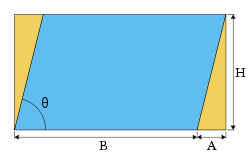Difference between revisions of "Parallelogram" - New World Encyclopedia
m (Robot: Remove claimed tag) |
Rosie Tanabe (talk | contribs) m |
||
| Line 3: | Line 3: | ||
In [[geometry]], a '''parallelogram''' is a [[quadrilateral]] with two sets of [[parallel]] sides. The [[opposite]] sides of a parallelogram are of equal length, and the opposite angles of a parallelogram are [[congruent]]. The three-dimensional counterpart of a parallelogram is a [[parallelepiped]]. | In [[geometry]], a '''parallelogram''' is a [[quadrilateral]] with two sets of [[parallel]] sides. The [[opposite]] sides of a parallelogram are of equal length, and the opposite angles of a parallelogram are [[congruent]]. The three-dimensional counterpart of a parallelogram is a [[parallelepiped]]. | ||
| − | + | {{toc}} | |
== Properties == | == Properties == | ||
| Line 86: | Line 86: | ||
== External links == | == External links == | ||
| + | All links retrieved March 23, 2015. | ||
| − | + | * Weisstein, Eric W. [http://mathworld.wolfram.com/Parallelogram.html Parallelogram] ''MathWorld—A Wolfram Web Resource.'' | |
| − | * Weisstein, Eric W. [http://mathworld.wolfram.com/Parallelogram.html Parallelogram] ''MathWorld—A Wolfram Web Resource.'' | + | *[http://www.mathwarehouse.com/geometry/quadrilaterals/parallelograms/index.php Parallelogram: Properties, Shapes, Diagonals and Area] |
| − | *[http://www.mathwarehouse.com/geometry/quadrilaterals/parallelograms/index.php Parallelogram: Properties, Shapes, Diagonals and Area] | + | * [http://www.mathopenref.com/parallelogram.html Parallelogram] ''Math Open Reference''. (Definition and properties.) |
| − | * [http://www.mathopenref.com/parallelogram.html Parallelogram] ''Math Open Reference''. (Definition and properties.) | + | * [http://www.mathopenref.com/parallelogramarea.html Area of a Parallelogram] ''Math Open Reference''. |
| − | * [http://www.mathopenref.com/parallelogramarea.html Area of a Parallelogram] ''Math Open Reference'' | + | * [http://www.cut-the-knot.org/Curriculum/Geometry/AreaOfParallelogram.shtml Area of Parallelogram] ''Cut The Knot''. |
| − | * [http://www.cut-the-knot.org/Curriculum/Geometry/AreaOfParallelogram.shtml Area of Parallelogram] ''Cut The Knot'' | + | * [http://www.cut-the-knot.org/Curriculum/Geometry/EquiTriOnPara.shtml Equilateral Triangles On Sides of a Parallelogram] ''Cut The Knot''. |
| − | * [http://www.cut-the-knot.org/Curriculum/Geometry/EquiTriOnPara.shtml Equilateral Triangles On Sides of a Parallelogram] ''Cut The Knot'' | + | * [http://agutie.homestead.com/files/VarigWitten.htm Varignon and Wittenbauer Parallelograms] |
| − | * [http://agutie.homestead.com/files/VarigWitten.htm Varignon and Wittenbauer Parallelograms] | + | * [http://agutie.homestead.com/files/vanaubel.html Van Aubel's Theorem: Quadrilateral with Squares] |
| − | * [http://agutie.homestead.com/files/vanaubel.html Van Aubel's Theorem: Quadrilateral with Squares] | + | * [http://www.kwiznet.com/p/takeQuiz.php?ChapterID=2623&CurriculumID=24 Parallelogram: Online Quiz] ''kwizNET Learning System''. |
| − | * [http://www.kwiznet.com/p/takeQuiz.php?ChapterID=2623&CurriculumID=24 Parallelogram: Online Quiz] ''kwizNET Learning System'' | ||
[[Category:Physical sciences]] | [[Category:Physical sciences]] | ||
Revision as of 19:51, 23 March 2015
In geometry, a parallelogram is a quadrilateral with two sets of parallel sides. The opposite sides of a parallelogram are of equal length, and the opposite angles of a parallelogram are congruent. The three-dimensional counterpart of a parallelogram is a parallelepiped.
Properties
- The two parallel sides are of equal length.
- The area, , of a parallelogram is where is the base of the parallelogram and is its height.
- The area of a parallelogram is twice the area of a triangle created by one of its diagonals.
- The area is also equal to the magnitude of the vector cross product of two adjacent sides.
- The diagonals of a parallelogram bisect each other.
- It is possible to create a tessellation with any parallelogram.
- The parallelogram is itself a special case of a trapezoid.
Vector spaces
In a vector space, addition of vectors is usually defined using the parallelogram law. The parallelogram law distinguishes Hilbert spaces from other Banach spaces.
Proof that diagonals bisect each other
To prove that the diagonals of a parallelogram bisect each other, first note a few pairs of equivalent angles:
Since they are angles that a transversal makes with parallel lines and .
Also, since they are a pair of vertical angles.
Therefore, since they have the same angles.
From this similarity, we have the ratios
Since , we have
- .
Therefore,
bisects the diagonals and .
Derivation of the area formula
The area formula,
can be derived as follows:
The area of the parallelogram to the right (the blue area) is the total area of the rectangle less the area of the two orange triangles. The area of the rectangle is
and the area of a single orange triangle is
Therefore, the area of the parallelogram is
See also
ReferencesISBN links support NWE through referral fees
- Arnone, Wendy. 2001. Geometry for Dummies. Hoboken, NJ: For Dummies (Wiley). ISBN 0764553240
- Hartshorne, Robin. 2002. Geometry: Euclid and Beyond. Undergraduate Texts in Mathematics. New York: Springer. ISBN 0387986502
- Leff, Lawrence S. 1997. Geometry the Easy Way. Hauppauge, NY: Barron’s Educational Series. ISBN 0764101102
- Stillwell, John. 2005. The Four Pillars of Geometry. Undergraduate Texts in Mathematics. New York: Springer. ISBN 0387255303
External links
All links retrieved March 23, 2015.
- Weisstein, Eric W. Parallelogram MathWorld—A Wolfram Web Resource.
- Parallelogram: Properties, Shapes, Diagonals and Area
- Parallelogram Math Open Reference. (Definition and properties.)
- Area of a Parallelogram Math Open Reference.
- Area of Parallelogram Cut The Knot.
- Equilateral Triangles On Sides of a Parallelogram Cut The Knot.
- Varignon and Wittenbauer Parallelograms
- Van Aubel's Theorem: Quadrilateral with Squares
- Parallelogram: Online Quiz kwizNET Learning System.
Credits
New World Encyclopedia writers and editors rewrote and completed the Wikipedia article in accordance with New World Encyclopedia standards. This article abides by terms of the Creative Commons CC-by-sa 3.0 License (CC-by-sa), which may be used and disseminated with proper attribution. Credit is due under the terms of this license that can reference both the New World Encyclopedia contributors and the selfless volunteer contributors of the Wikimedia Foundation. To cite this article click here for a list of acceptable citing formats.The history of earlier contributions by wikipedians is accessible to researchers here:
The history of this article since it was imported to New World Encyclopedia:
Note: Some restrictions may apply to use of individual images which are separately licensed.
























